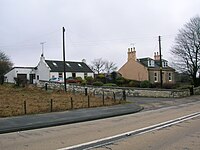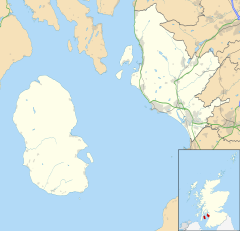Human settlement in Scotland
Barkip
| |
|---|---|
 A view of The Den A view of The Den | |
 | |
| OS grid reference | NS 32640 51244 |
| Council area | |
| Lieutenancy area | |
| Country | Scotland |
| Sovereign state | United Kingdom |
| Dialling code | 01505 |
| Police | Scotland |
| Fire | Scottish |
| Ambulance | Scottish |
| UK Parliament | |
| Scottish Parliament | |
| 55°43′32″N 4°39′59″W / 55.725614°N 4.666426°W / 55.725614; -4.666426 | |
Barkip, also known as The Den, is a hamlet in North Ayrshire, Scotland about three miles (five kilometres) southwest of Beith on the A737 road to Dalry. The earliest recorded name is 'Blairkip'. In the Gaelic language, the name Barkip comes from bar ("top"), and kip ("a rank of soldiers"). It is not clear when or why the name 'The Den' started to be used although it appears in the local press as both in 1898, however in Scots as in old English one meaning is 'A hollow between hills,' which is certainly an accurate description of the geography of the area that Barkip lies in. Following construction of a new road, Barkip no longer sits on the main Beith to Dalry road.
History
Pont's survey of the early 1600s records a 'Bar-Kyipe' lying in the Barony of Kersland and Dobie records that Barkip formed part of the estate of Roughwood in 1874, belonging to William Ralston-Patrick. In the 19th century the population was 995.
Willem Blaeu's map of circa 1604 records a 'Barkirsh' settlement, probably today's nearby 'Barcosh'. William Roy's map of 1747 records the settlements of Mallside and a Blairkip. In the year 1726, William Park and John his son granted to John Hamilton an heritable bond, in common form, for 3000 merks, over the lands of Barkip. Barkip was part of the Blair Estate.
In March 1898, a local paper reported a complaint that a dance had taken place at the Kersland Barony school and Kirk that had lasted into the small hours. Members of the church congregation threatened to leave through their indignation at the building being used for such frivolous activities. That same month, students at the Kersland Barony evening continuation classes presented their teachers, Mr Deans and Miss Lorraine, with gifts of appreciation. The Rev A Leslie chaired the event and Miss Lorraine was presented with an inscribed umbrella, whilst Mr Deans had a silver walking stick as his recognition. Songs, recitations, flute, and violin entertainments were part of the night's proceedings.
An 1876 publication, Catalogue of the western Scottish fossils, documented finds in Barkip's coal and ironstone pits and sandstone quarries, including that of Rhizodus, Gyracanthus, and Cladodus. The village had a certain reputation for problems linked to illicit drinking. It was reported in 1898 that Sunday drinking resulted in men lying around drunk in the Maulside plantations and some were playing cards. Jame Walker is recorded as being born on 4 September 1795 and lived at 20 Fore Row, 23 Barkip, The Den.
Geography
Geologically, Barkip consists of mainly sandstone. Two areas of the rare habitat type known as 'raised bogs' are located at Barkip and Little Barkip. These were surveyed for the Ayrshire Biodiversity Action Plan (ABAP) by the NAC Ranger Service in 2010. Raised bogs develop over centuries from open lake, to marsh, and eventually bog that continues to form peat, and over time a shallow dome of bog peat develops: a raised bog. The dome is typically a few metres high in the centre, and is often surrounded by strips of fen. The Barkip sites have the typical bog plants, such as sundew, cotton grass, deer grass, and sphagnum mosses. Highfield is the next village along on the A737 towards Dalry.
Notable landmarks
The old Kersland Barony school had a church-like belfry over the front gale and was used as church on Sundays. The Rev. Robert Stevenson D.D., minister of Dalry 1844–1890, caused to be erected the Kersland Barony Chapel and school. He bequeathed £2,500 for Kersland Barony chapel. In 1901 the Herald recorded that "The scholars of Kersland Barony School, Dalry, under the direction of Mr Deans, headmaster, and Mr Gibson, drill instructor, gave a most enjoyable entertainment on two evenings last week". The village at one time had a police station, two public houses, a cinema, and a bowling green. Brackenhills railway station was located midway between Beith and Barkip on the Lanarkshire and Ayrshire Railway's branch to Kilbirnie South. Defence Munitions Beith (DM Beith) is located nearby. The hamlet contains several cottages including Auchengree Cottage, Rosehill Cottage and Muirhouse Cottage. A smithy was located at the Crossroads near where Graze Restaurant once stood. A second smithy was situated on the crossroads near West Muirhouse Farm and Highden House. This smithy, now demolished, was unusual in that it had stables associated with it; these survive as a private dwelling. An explosives magazine was located at the site of the old Low Well opposite West Muirhouse Farm. Davidshill House was once an isolation hospital, locally known as the 'Sick House'.
Maulside House, previously Maulhead, was built on the site of an earlier mansion held by the Russells. The present house was built for Andrew Mitchell, Writer to the signet, in the 1830s. he improved his estate lands, draining the mosses, turning them into productive fields. Maulside Mains is a 'B' Listed, early 19th century, rectangular-plan stable block with a U-shaped courtyard beyond. William Ronald, farmer at Mauleside, had been a gauds boy to Burns at Lochlea Farm, helping him with the ploughing by encouraging and guiding the team of horses whilst carrying a plough staff to clean the ploughshare when it clogged with earth.

Located a short distance from the settlement is the Barkip Biogas power plant, the largest anaerobic digestion power plant in Scotland when completed in June 2011. It uses anaerobic digestion to produce electricity from leftover food and other organic materials. The only by-product is a high nutrient fertiliser that can be returned to the land to help produce more food. The Barkip Biogas facility was built for the utility provider Scottish & Southern Energy Generation Ltd. It is operated by Zebec Energy, a West of Scotland company. The facility has the capacity to process up to 75,000 tonnes-a-year of residual waste and has been designed to produce up to 2.5 megawatts (MW) of renewable electricity. The plant was officially opened by the Duke of Rothesay (Prince Charles) in May 2012.
Notable people
- Jean Gilbert OBE, born at Barkip Farm in 1942 near The Den. North Ayrshire Council's 'Citizen of the Year' for 2012.
- David Mackie, superintending engineer for the Barkip Coal & Ironstone Works
- Thomas Macqueen, poet, author of " The Exile".
- Andrew Mitchell, Esq. of Maulside was recorded as one of the principal landowners within the Parish of Dalry. He was a Glasgow Writer to the Signet.
- William Ronald, farmer at Maulside and once a gauds boy to Robert Burns at Lochlie Farm.
Views of Barkip in 2011
The Den
|
References
Notes
- ^ Reid (2001), p.105
- ^ Roy's Map Retrieved : 18 February 2012
- Mackay, John; Maclean, Annie; Mackay, Sharp (1892). The Celtic monthly: a magazine for Highlanders (Public domain ed.). Archibald Sinclair, Celtic Press. pp. 22–. Retrieved 19 February 2012.
- ^ Reid (2001), p. 119
- Dene (valley).
- Scots Dictionary Retrieved : 2012-02-20
- Dobie, Page 85
- McGeorge, Page 166
- Blaeu's Map Retrieved : 18 February 2012
- Scotland. Court of Session; William Maxwell Morison (1801). The decisions of the Court of Session: from its first institution to the present time : digested under proper heads, in the form of a dictionary. Bell. p. 326. Retrieved 19 February 2012.
- Rootsweb Retrieved : 2012-02-20
- Catalogue of the western Scottish fossils (Public domain ed.). Blackie. 1876. pp. 76–. Retrieved 19 February 2012.
- Geological Society of Glasgow (1868). Transactions of the Geological Society of Glasgow. Soc. p. 289. Retrieved 19 February 2012.
- Dalry History Group, Page 108
- Love, p.84
- Dalry Trinity Church Retrieved : 2012-05-27
- Three Towners Archived 2012-05-16 at the Wayback Machine Retrieved : 2012-05-27
- Reid (2001), p. 86
- Old Maps Archived April 30, 2012, at the Wayback Machine Retrieved : 2012-02-26]
- Dobie, Page 326
- ^ Love (2003), Page 84
- British Listed Buildings Retrieved : 2012-02-26
- Boyle, Andrew (1996). Ayrshire Book of Burns-Lore. Alloway Publishing. p. 102. ISBN 9780907526711.
- letsrecycle.com Retrieved : 2012-02-21
- "Barkip AD Plant Progress Update, 18/2/11". William Tracey Ltd. 18 February 2011. Archived from the original on 11 July 2012. Retrieved 20 February 2012.
- Reid, Chapter 3
- Blackmar, Frank Wilson (1912). Kansas: a cyclopedia of state history, embracing events, institutions, industries, counties, cities, towns, prominent persons, etc. ... with a supplementary volume devoted to selected personal history and reminiscence (Public domain ed.). Standard publishing company. pp. 482–. Retrieved 19 February 2012.
- M'Kie, James (1867). Title pages, and imprints, of the books in the private library of James M'Kie, Kilmarnock. p. 55. Retrieved 19 February 2012.
- Family Search Retrieved : 2012-02-26
- Kinniburgh, Page 103
Sources
- Dalry History Group (1985). Dalry Remembered. ISBN 0-9510674-0-0.
- Dobie, James D. (ed Dobie, J.S.) (1876). Cunninghame, Topographized by Timothy Pont 1604–1608, with continuations and illustrative notices. Glasgow: John Tweed.
- Kinniburgh, Moira and Burke, Fiona (1995). Kilbirnie and Glengarnock. Shared Memories. Kilbirnie Library. ISBN 1-897998-01-5.
- Love, Dane (2003). Ayrshire : Discovering a County. Ayr : Fort Publishing. ISBN 0-9544461-1-9.
- McMichael, George. Notes on the Way. Ayr : Hugh Henry.
- Reid, Donald L. (2001). In the Valley of Garnock. Beith : D. Reid & the Jolly Beggars Burns Club. ISBN 0-9522720-6-7.
- Reid, Donald L. (2011). Beith, Barrmill and Gateside. Beith : D. Reid & the Jolly Beggars Burns Club. ISBN 978-0-9566343-1-3.
- Reid, Donald & Monahan, Isobel F. (1999). Yesterday's Beith. Beith : DoE. ISBN 0-9522720-5-9.
External links
- Video and commentary on Barkip / 'The Den'.
- Video and commentary on the old Kersland Barony School and Church at Barkip
- Video and commentary on the area surrounding Barkip / 'The Den'.
- The Little Barkip Biogas Powerstation.
| North Ayrshire | |
|---|---|
| Towns | |
| Villages, suburbs and hamlets | |
| Constituencies |
|
| See also List of places in North Ayrshire | |



